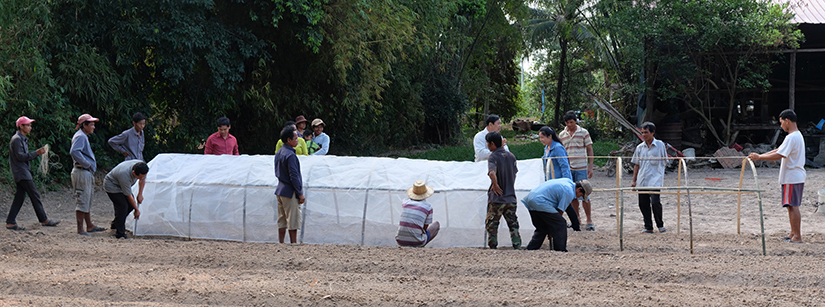

Editor’s note: This blog post by Poonpipope “Poon” Kasemsap was originally a presentation given at the Horticulture Innovation Lab’s 2017 annual meeting.
Kasemsap an associate professor at Kasetsart University in Thailand and also the director of the Horticulture Innovation Lab Regional Center at KU. The center brings together key regional players to circulate technical assistance and innovative technologies in support of smallholder farmers and small business in Thailand, Cambodia, Bangladesh and Nepal.
Pest-exclusion nets are one of the technologies for horticulture development promoted by the Horticulture Innovation Lab. The nets can be easy to use and can also serve as floating row covers to control temperature, light, relative humidity and soil moisture for plant production. Some of the pest-exclusion nets used by Horticulture Innovation Lab researchers are made and marketed locally by mosquito net manufacturers.
But why should you consider using nets for pest management? Here are 7 considerations in adopting nets for agricultural use, inspired by Sun Tzu’s The Art of War:
- The greatest victory is that which requires no battle:
The nets create a barrier that protects vegetables against pests and associated diseases, and thus provide an inexpensive and safe method of managing insect pests while reducing risks associated with pesticides to both farmers and consumers. The pest-exclusion nets provide an excellent example of victory (against certain insects) which requires no battle (insecticide). Winrock International chose pest-exclusion nets to be the initial horticulture package in Feed the Future Asia Innovative Farmers Activity project funded by USAID. - Know yourself:
This tip focuses on flexibility, convenience and versatility. Pest-exclusion nets could serve as floating row or field covers with no permanent structure or be built into several types of structure including net-box, low tunnels, medium tunnels, high tunnels or full canopy, depending on the crops or financial factors. - Know your enemy:
The pest-exclusion nets have a potential to help protect against a wide range of potential problem insects and animals such as flying foxes, birds, fruit piercing moths, fruit spotting bugs, macadamia nut borers, fruit flies, wallabies, hares and possums. In order to choose the appropriate material and structure for the nets (including mesh size), it is essential that farmers know (a) what insects/animals they need to exclude from the crops and (b) the potential changes in the micro-climate inside the nets.
Borarin Buntong and Soth Hong, researchers from the Royal University of Agriculture in Cambodia, stand in front of a campus experiment comparing two different types of net structures with eggplant, tomato, Chinese kale, pak choy and Chinese mustard — in partnership with researchers from Kasetsart University and Winrock International. (Photo by Kim Fooyontphanich/Kasetsart University) - Every battle is won before it is fought:
It is obvious that careful analysis, planning, and preparation are the main key success factors for the implementation of the pest-exclusion net technology. In addition, other non-production technical factors such as logistics and marketing would likely be significantly important. For example, applying pest-exclusion nets to jasmine production has been possible and substantially profitable because of much higher price command during the winter season. Success from adopting pest-exclusion nets relies on careful planning, both on- and off-farm.
Ta Keo of Cambodia’s Kandal province was an early adopter of net houses, with neighboring farmers learning from his success during a Horticulture Innovation Lab project led by UC Davis with partnership from RUA. (Horticulture Innovation Lab photo by Brenda Dawson/UC Davis) - Opportunities multiply as they are seized:
Early adopters serve as models for local dissemination. Successes by early adopters of certain technologies could lead to more opportunity by everyone in the local village. If one farmer in the rural village of Chiang Mai invests successfully in pest-exclusion nets to produce high quality, organic vegetables, then several more farmers in the same village start to learn from him. The group can keep expanding until it has enough visibility and thus providing more opportunities and bargaining power with buyers. - Move only if there is a real advantage to be gained:
Once successful, there are tendencies to over-expand. It is crucial for the farmers to analyze carefully the marginal cost and marginal gain. They must decide to implement the pest-exclusion nets only if there is real advantage to be gained. Keep in mind that every technology has limitations. - If a battle cannot be won, do not fight it:
If careful analysis provides the result that risk is too high with low or no return on investment, do not insist on continuing with the implementation of the technology. Pest-exclusion nets are not going to be successful everywhere in the world. There will be other circumstances that this technology will be useful and valuable.
More information:
- More about the Horticulture Innovation Lab Regional Center at Kasetsart University
- Nets factsheet PDF: Pest-exclusion nets protect crops to boost yield
- Nets-related research project: Assessing feasibility of pest-exclusion nets in Kenya
- Nets-related blog post: 5 ways relationships promote innovation – and can improve food safety
- More 5-Minute Lesson blog posts
